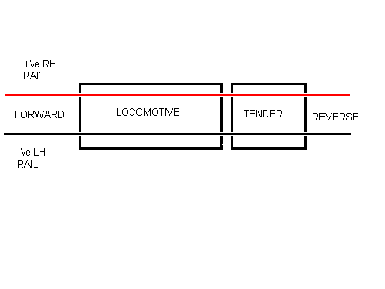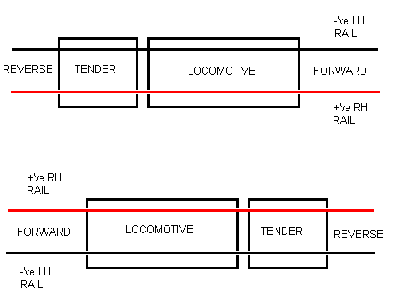


WHICH WAY IS FORWARD?
We now need to get to grips with some of the more common terms used and misused in the hobby.
For example:
What do the terms ‘Forward’ and ‘Reverse’ on our controllers mean?
Here is rule 15 again:
NUMBER RULE
15 When a locomotive is moving FORWARD with the controller set to the`Forward’ direction then the RIGHT HAND rail – That is, the RH one when viewed from the tender end looking forward – will be `POSITIVE’ in
relation to the LEFT HAND rail.

This is commonly known as the ‘Right Hand Rule.
So far we have mainly considered a single controller and how it affects the one locomotive we want to move. Remember, the controller does not control trains or engines directly; they simply control the electrical polarity and voltage potential of the rails.
This is ‘indirect’ control because a locomotive’s motor, connected to the rails, responds to changes in polarity and voltage.
Any number of locomotives placed on the track fed by a single controller can only respond together to the polarity and voltage delivered by the controller – to the limit of its current capacity of course.
So long as the layout is fairly simple and is operated single-handed, this is adequate.
Now, suppose we have a system with sufficient room and a desire to run two or more trains, ‘independently’, on separate tracks. These would be linked together by pointwork. Obviously, we are going to need two or more controllers.
However, adding a second controller does not give us independent control of more than one locomotive or train at a time.
If we were to feed the same track with two controllers then this will lead to a ‘Short Circuit’ if one of the controllers is set such that the polarity of each does not match. That is to say, we set the ‘Reverse’ switch on one controller different to the other.
The simplest type of layout that permits ‘independent’ operation of two trains at the same time is, of course, a double-track system.
Consider the diagram below:
The upper diagram represents the ‘UP’ main line and the lower diagram the ‘DOWN’ main line

What do the terms ‘Forward’ and ‘Reverse’ on our controllers now mean?
Remember, Rule 15, the Right Hand Rule, MUST ALWAYS apply
We offer you the following simple, yet, we believe, a very effective solution. The ‘Forward/Reverse’ Switch on the controller should become a ‘Move to the LEFT’ or a ‘Move to the RIGHT’ switch instead.
If we wire each controller such that the output polarity to the track is as shown in the diagram above then the terms ‘Forward’ and ‘Reverse’ will apply to each line separately!
We do not need to know which direction is ‘Forward’ and which ‘Reverse’ is because it no longer matters - if you set the switch or Control Knob to the LEFT then the Locomotive will move to the LEFT. Similarly, set ti to the RIGHT and the Locomotive will move off to the RIGHT.
With double running lines that follow standard British practice we have achieved directional stability. The controller powering the ‘UP’ main line will be switched to the RIGHT to move the train in that direction and to the LEFT to go in that direction.
The ‘DOWN’ main line controller switch is wired in exactly the same way. Thus, we will have a situation where two locomotives are both moving forward and yet one is moving in a ‘clockwise’ direction and the other is moving in the opposite, ‘anti-clockwise’, direction.
The operator simply has to look at the switch position on the controller to see which direction the locomotive will move off in when a voltage is applied using the control knob.
So, how do we control two or more trains, independently?
There are two methods. The first method involves dividing the layout into electrically isolated ‘Track Sections’ or ‘Blocks’.
The term ‘Blocks’ ties in very nicely with the term used to describe a discrete section of track controlled by signals. Unfortunately, the use of this signalling term opens up a whole new can of worms for us to consider, as you will see shortly.
These ‘Track Sections’ are then wired to the controllers through electrical selector switches.
This method is called ‘CAB CONTROL’.
The second method in relatively new in the UK and is ‘COMMAND CONTROL’.
Both of these topics will be the subject of later articles.